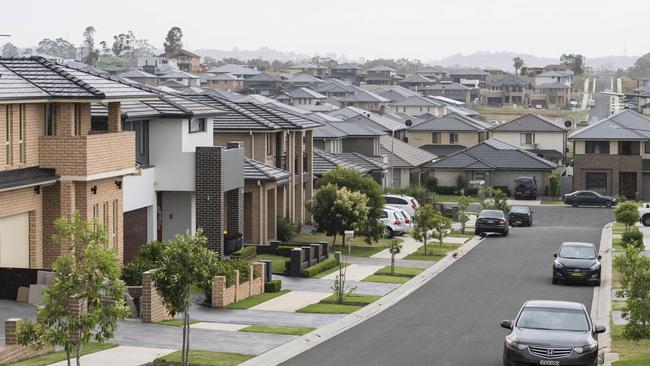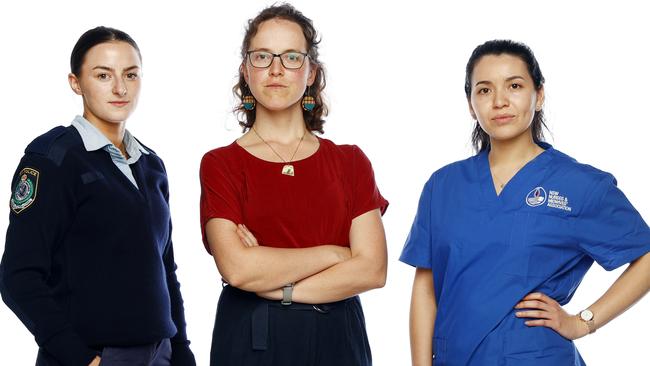Sydney housing supply and affordability crisis branded an epic fail of all levels of government
The great Australian dream is at risk of dying out with key workers who drive our city — police officers, teachers, nurses and firefighters — no longer able afford a house in Sydney.

NSW
Don't miss out on the headlines from NSW. Followed categories will be added to My News.
Sydney’s housing crisis has been condemned as an epic fail of governance at every level that is hurting us all.
“Nowhere is this more apparent than in Western Sydney,” Tom Forrest, chief executive of The Urban Taskforce said.
“The planning system has delivered rezoning to support urban growth – but it has done so without reference to market demand.
“Worse, entire new suburbs were planned – but no-one appears to have spoken to the key infrastructure providers.”

The Greater Sydney Commission has predicted at Rossmore near Liverpool that there should be almost 12,000 new dwellings built there by 2056 and has been identified as a high density housing area.
“But 95 per cent of the Rossmore precinct is fragmented into hundreds of small, intensive agricultural lots that can never be part of a single major development,” Mr Forrest said.
Next door at Leppington planners have rezoned the area for medium to high rise residential development but without the necessary infrastructure.
“We need more high-density development in other areas of Sydney like Bondi or Chatswood but not in the middle of a green field site in Leppington,” Mr Forrest said.
In the last month approvals for new housing have dropped by 25 per cent while across Sydney the average home has surged in value by 22 per cent over the last year.
Property Council of Australia NSW Executive Director Luke Achterstraat said the government could address the housing affordability crisis by increasing supply.
“It is a disgrace that only one in 35 local councils in greater Sydney are on track to meet their own housing targets set by the government. There should be greater accountability for local councils who give into NIMBYism and refuse to make the tough but right calls for the community,” he said.

Department of Planning projections for the next five years show that most Western Sydney councils are expected to fail to meet the home building targets they agreed with the Greater Sydney Commission by as much as 46 per cent.
Wollondilly Council agreed to build 2,224 new homes but is on track to build just over half that number while Hawkesbury Council is expected to build just 600 of its 1,100 home target.
“We are some 100,000 homes short of where we need to be, and that is even without net migration. The government’s own reporting says we need to build 42,000 new homes per year and just under 30,000 were completed last year. The supply deficit is likely to continue without dramatic intervention,” Mr Achterstraat said.
“State governments have an obligation to facilitate more housing supply by building enabling infrastructure, slashing red-tape in the planning system and removing bottlenecks for approvals,” he said.
“We are delighted the government has appointed a Minister for Planning and Homes and we look forward to working closely with the government to reform and improve our planning system to help Australians achieve their ownership dream.”

That new Minister, Anthony Roberts, knows he has a mammoth task ahead of him. “We know there is a housing crisis in NSW,” Mr Roberts said.
“My priorities as Minister are to increase housing supply, particularly in regional NSW, and providing greater access to a variety of housing options, including affordable housing which includes Aboriginal and key worker housing.”
Mr Roberts said he will look to cut red tape which “will require collaboration and co-operation across several government agencies and different levels of government.”
And in good news for Western Sydney he said “we need to continue streamlining our Development Application process for faster approvals, and supporting more land re-zonings.”
Mr Roberts also said he was working on delivering around 120 projects in western and southwestern Sydney that could see up to 17,000 new homes built.
The problem is that, according to all of the property experts, that is nowhere near enough.
KEY WORKERS UNABLE TO AFFORD A SYDNEY HOME

The great Australian dream is at risk of dying out.
The key workers that drive our city — police officers, teachers, nurses and firefighters — can no longer afford to buy a house in Sydney.
And those that can, face long commutes because they cannot afford to buy where they work.
“It’s very disheartening that a potential future, something I fantasised for a very long time, might not come to fruition because I’m not going to be in a position to buy anything,” Melissa Suarez, 26, said.
Ms Suarez, a registered nurse working at a major south west Sydney hospital, lives at home with her parents and said the seeming impossibility of buying her own home had driven her to consider moving out of Sydney.
“It’s going to get to the point where I may have to move out of Sydney … it’s not something I want to do,” she said.
“I often joke with my parents that I’ll live with them until I’m 40, but it’s becoming more and more of a reality unfortunately.”
First year police constable Melissa Bentley is set to trade a 15-minute commute to her current Western Sydney police station for an hour and a half drive from the Central Coast, where her and her partner are considering buying a house and land package after being locked out of the city’s impenetrable housing market.
“Even with both of our wages being decent wages, we can’t even get the pre-approval for Sydney,” she said. “I worry about the travel to and from work but to own a house I guess it’s what you have to do.”
“At the moment, it’s a wedding or a house. So, we’re stuck — but the house comes first.”
When Ms Bentley moves she’ll be among the 44,000 key workers who commute more than 30km to work in Sydney, according to a landmark report commissioned by the Australian Housing and Urban Research Institute (AHURI).
That report also found that between 2011 and 2016, the inner regions of Sydney experienced a “net loss of key workers”.
For teacher Sierra Classen, years of scrimping and saving with her partner meant she could finally afford to buy a south Sydney home two years ago — an hour long commute “on a bad day” to her work at Redfern. She works a second job to make ends meet.
“I still work massive hours, I still work an extra job. Once you buy the house, you still have to pay the mortgage,” she said.
Originally published as Sydney housing supply and affordability crisis branded an epic fail of all levels of government




